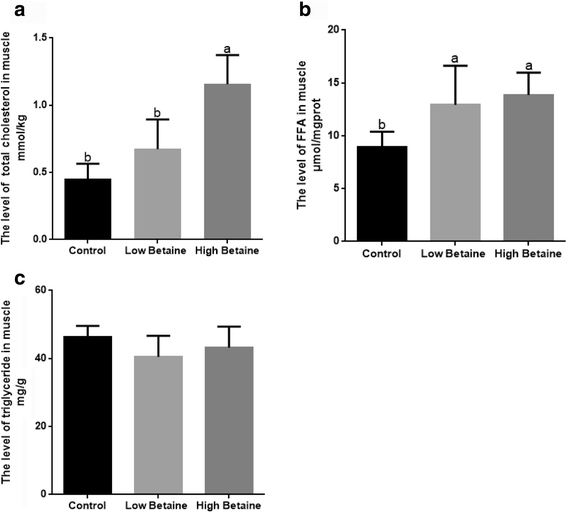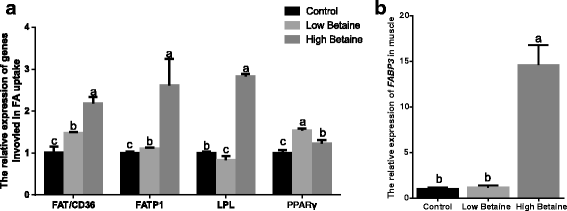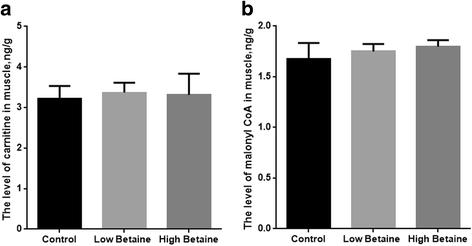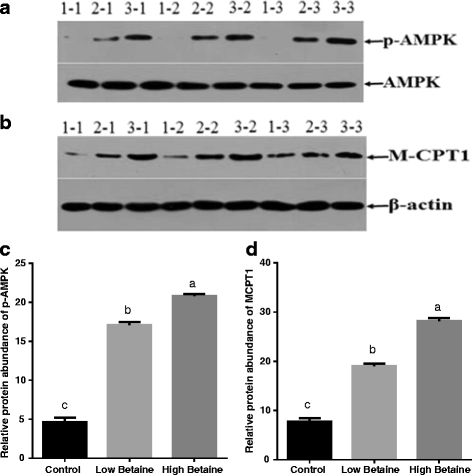Betaine affects muscle lipid metabolism via regulating the fatty acid uptake and oxidation in finishing pig
- PMID: 28883917
- PMCID: PMC5580292
- DOI: 10.1186/s40104-017-0200-6
Betaine affects muscle lipid metabolism via regulating the fatty acid uptake and oxidation in finishing pig
Abstract
Background: Betaine affects fat metabolism in animals, but the specific mechanism is still not clear. The purpose of this study was to investigate possible mechanisms of betaine in altering lipid metabolism in muscle tissue in finishing pigs.
Methods: A total of 120 crossbred gilts (Landrace × Yorkshire × Duroc) with an average initial body weight of 70.1 kg were randomly allotted to three dietary treatments. The treatments included a corn-soybean meal basal diet supplemented with 0, 1250 or 2500 mg/kg betaine. The feeding experiment lasted 42 d.
Results: Betaine addition to the diet significantly increased the concentration of free fatty acids (FFA) in muscle (P < 0.05). Furthermore, the levels of serum cholesterol and high-density lipoprotein cholesterol were decreased (P < 0.05) and total cholesterol content was increased in muscle (P < 0.05) of betaine fed pigs. Experiments on genes involved in fatty acid transport showed that betaine increased expression of lipoprotein lipase(LPL), fatty acid translocase/cluster of differentiation (FAT/CD36), fatty acid binding protein (FABP3) and fatty acid transport protein (FATP1) (P < 0.05). The abundance of fatty acid transport protein and fatty acid binding protein were also increased by betaine (P < 0.05). As for the key factors involved in fatty acid oxidation, although betaine supplementation didn't affect the level of carnitine and malonyl-CoA, betaine increased mRNA and protein abundance of carnitine palmitransferase-1(CPT1) and phosphorylated-AMPK (P < 0.05).
Conclusions: The results suggested that betaine may promoted muscle fatty acid uptake via up-regulating the genes related to fatty acid transporter including FAT/CD36, FATP1 and FABP3. On the other hand, betaine activated AMPK and up-regulated genes related to fatty acid oxidation including PPARα and CPT1. The underlying mechanism regulating fatty acid metabolism in pigs supplemented with betaine is associated with the up-regulation of genes involved in fatty acid transport and fatty acid oxidation.
Keywords: Betaine; Fatty acid intake; Fatty acid oxidation; Muscle; Pig.
Conflict of interest statement
Ethics approval
The experiment protocols used in this study was approved by the Institutional Animal Care and Use Committee of Zhejiang University.
Consent for publication
Not applicable.
Competing interests
The authors declare that they have no completing interests.
Figures







Similar articles
-
Long-Term Dietary Supplementation with Betaine Improves Growth Performance, Meat Quality and Intramuscular Fat Deposition in Growing-Finishing Pigs.Foods. 2023 Jan 20;12(3):494. doi: 10.3390/foods12030494. Foods. 2023. PMID: 36766024 Free PMC article.
-
Influence of betaine and arginine supplementation of reduced protein diets on fatty acid composition and gene expression in the muscle and subcutaneous adipose tissue of cross-bred pigs.Br J Nutr. 2016 Mar 28;115(6):937-50. doi: 10.1017/S0007114515005218. Br J Nutr. 2016. PMID: 26819073 Clinical Trial.
-
Impact of betaine on pig finishing performance and carcass composition.J Anim Sci. 2002 Feb;80(2):475-82. doi: 10.2527/2002.802475x. J Anim Sci. 2002. PMID: 11881932
-
Regulation of energy metabolism by long-chain fatty acids.Prog Lipid Res. 2014 Jan;53:124-44. doi: 10.1016/j.plipres.2013.12.001. Epub 2013 Dec 18. Prog Lipid Res. 2014. PMID: 24362249 Review.
-
Contribution of FAT/CD36 to the regulation of skeletal muscle fatty acid oxidation: an overview.Acta Physiol (Oxf). 2008 Dec;194(4):293-309. doi: 10.1111/j.1748-1716.2008.01878.x. Epub 2008 Jul 9. Acta Physiol (Oxf). 2008. PMID: 18510711 Review.
Cited by
-
The effects of chronic betaine supplementation on body composition and performance in collegiate females: a double-blind, randomized, placebo controlled trial.J Int Soc Sports Nutr. 2018 Jul 31;15(1):37. doi: 10.1186/s12970-018-0243-x. J Int Soc Sports Nutr. 2018. PMID: 30064450 Free PMC article. Clinical Trial.
-
Pharmacological Applications and Action Mechanisms of Phytochemicals as Alternatives to Antibiotics in Pig Production.Front Immunol. 2021 Dec 9;12:798553. doi: 10.3389/fimmu.2021.798553. eCollection 2021. Front Immunol. 2021. PMID: 34956234 Free PMC article. Review.
-
Dietary methionine deficiency stunts growth and increases fat deposition via suppression of fatty acids transportation and hepatic catabolism in Pekin ducks.J Anim Sci Biotechnol. 2022 May 18;13(1):61. doi: 10.1186/s40104-022-00709-z. J Anim Sci Biotechnol. 2022. PMID: 35581591 Free PMC article.
-
Transcriptomics and metabolomics insights into the seasonal dynamics of meat quality in yak on the Qinghai-Tibetan Plateau.BMC Genomics. 2024 Dec 18;25(1):1194. doi: 10.1186/s12864-024-11093-5. BMC Genomics. 2024. PMID: 39695977 Free PMC article.
-
Arecoline regulates glycolipid and endoplasmic reticulum metabolisms in adult grass carp (Ctenopharyngodon idella).Anim Nutr. 2025 Apr 5;21:447-461. doi: 10.1016/j.aninu.2024.12.007. eCollection 2025 Jun. Anim Nutr. 2025. PMID: 40510831 Free PMC article.
References
-
- Eklund M, Bauer E, Wamatu J, Mosenthin R. Potential nutritional and physiological functions of betaine in livestock. Nutr Res Rev. 2005;18(01):31–48. - PubMed
-
- Craig SAS. Betaine in human nutrition. Am J Clin Nutr. 2004;80(3):539–49. - PubMed
-
- Wray-Cahen D, Fernández-Fígares I, Virtanen E, Steele NC, Caperna TJ. Betaine improves growth, but does not induce whole body or hepatic palmitate oxidation in swine (Sus Scrofa Domestica). Comp Biochem Physiol A Mol Integr Physiol. 2004;137(1):131–40. - PubMed
-
- Fernández-Fígares I, Wray-Cahen D, Steele NC, Campbell RG, Hall DD, Virtanen E, et al. Effect of dietary betaine on nutrient utilization and partitioning in the young growing feed-restricted pig. J Anim Sci. 2002;80(2):421–8. - PubMed
-
- Schrama JW, Heetkamp MJW, Simmins PH, Gerrits WJJ. Dietary betaine supplementation affects energy metabolism of pigs. J Anim Sci. 2003;81(5):1202–9. - PubMed
LinkOut - more resources
Full Text Sources
Other Literature Sources
Research Materials
Miscellaneous

